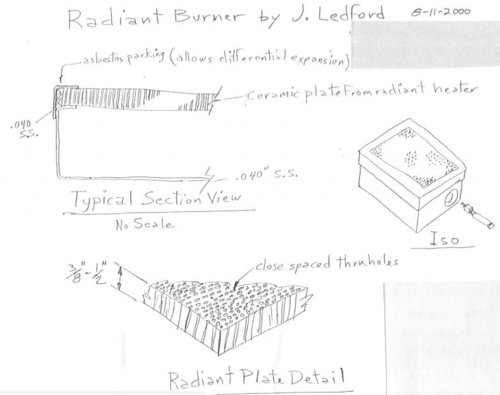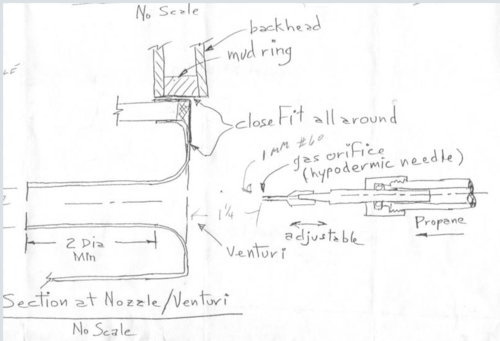John Ledford's Radiant Burner
Rich Carlstedt posted on Chaski.org
- Back in 2000, at the IBLS Meet in Burnaby B.C. a fellow from New Mexico, John Ledford, had his locomotive successfully powered with ceramic burners. This was in a 7-1/2 inch gauge loco. John was a scientist at the National Lab in Los Alamos and very intelligent. The secret for heat as I recall was to use liquid propane, instead of the normal regulator air mixer method. The liquid injector looked like a hypo needle, and no flame was seen as the ceramic glowed a very bright orange/red.
- John's design consisted of a stainless steel box that was mounted at the mudring and below, with NO air allowed to come in around the box,and which had a ceramic core on it's top, in the firebox. The box had a 1 inch diameter tube introducing the gases into the middle of the box. The tube was a venturi with a hypo needle feeding liquid propane in it's center. You must have no draft! So the Petticoat pipe is eliminated and exhaust steam is piped to the top of the stack. The only oxygen is what comes in at the venturi with the propane since it is all sealed. That way all combustion remains within the ceramic radiant heater in a controlled form.
- What was amazing was I could place my hand under the bottom of the stainless steel box and feel no heat. All the heat is radiated into the firebox and the bottom of the box is cooled by the incoming air and expanding propane (You know how the regulator in propane system gets ice cold..this expansion occurs in the bottom of the SS box). The burner was incandescent and no flame is seen after it warms up. Also, unlike conventional propane burners with primary and secondary air holes, no flames ever licked your legs when you chopped the throttle (been there, done that).
Propane Burner for Boilers Notes
by John Ledford
Permission granted to copy and distribute.
The problem with most propane burners is the excess air coming up and around them. This excess air is cool and does not aid the heat transfer into the water. This burner design induces only enough air at the venturi for complete combustion. A close fit at the mud ring excludes all other air but this causes an interesting problem for the draft. Forced draft will pull the fuel mix through the ceramic plate too fast for the combustion process. I have a separate tube in the stack from the nozzle to the top of the stack. I also have the smokebox door spaced away from the front about 1/16 inch to let in air that is still induced by the exhaust and/or to let the exhaust side of the burner operate at atmospheric pressure. My source for the cermaic plate was from a local supplier as a replacement part for a warehouse type radiant heater. I bought a piece that was larger and cut it to fit. My "box" is sized to approximate the ash pan space of the Heisler design so includes a tunnel for the drive shaft although other designs wouldn't require it. For my engine I used a one inch diameter tube, flared out to form the venturi and a #19 hypodermic needle for the gas jet. The propane is unregulated and I used a needle valve to control the fire. After the valve I have a pressure gauge to set the firing pressure (I use up to 35 psi for hard work). Light off requires no blower, compressed air or fan.
The following is from "Standard Handbook for Mechanical Engineers", Baumeister & Marks, Seventh Edition, McGraw-Hill:
- Surface Combustion. If, after forcing combustible gas through a porous mass of refractory material, igniting, and allowing it to burn in the air with the usual flame, air is forced in with the gas so that the resulting explosive mixture flows with too great velocity for backfiring to occur, the flame becomes non-luminous and, as the surface of the refractory mass is heated up, gradually disappears from the surface of the material, which glows under the action of the surface combustion. The combustion, which is supported by the oxygen admitted with the gas and is not influenced by the oxygen in front of the refractory mass, may be perfect with a minimum of excess air. In the case of a porous slab or diaphragm, the combustion takes place within a distance of from 1/8 to 1/4 inches from the surface. This method of heating has been applied to muffles and crucibles, where the porous refractory material, in the form of small lumps, is closely packet in the interspaces. Muffles can be kept steadily at a temperature of 2700 F (3600 F attainable) with the use of only one-half the amount of gas required in the older method of firing. The advantages of this method of combustion, according to Prof. W.A. Bone (Engineering, Apr 14, 1911), are that combustion is accelerated by the incandescent surface, the heat developed can be concentrated just where it is required, very high temperatures are attainable without the use of regenerators, and the energy is converted into radiant form which is transmitted very rapidly to the object exposed to it.

